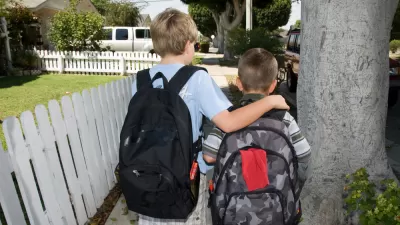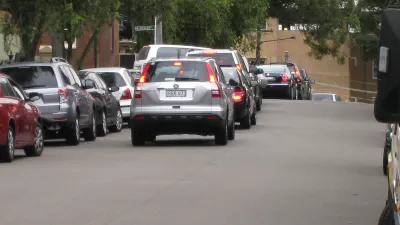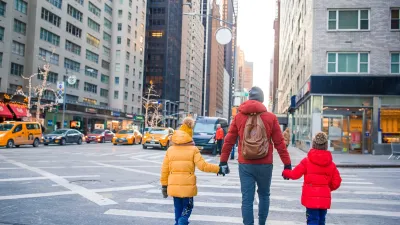The advent of sprawl coincided with a move toward earlier school start times, prompted by a need to coordinate complicated bussing. If students could walk to school, the problem might disappear.

It's hard to believe as a younger person, but before mass suburbanization school used to start at 9 a.m. or later. That isn't the case today. Mimi Kirk writes, "according to the Centers for Disease Control and Prevention, at least 75 percent of schools surveyed in more than 40 states for a 2015 report started before 8:30 a.m., with a significant number starting in the 7 a.m. hour."
Why the change? Kirk traces it to the 1960s and 1970s, when sprawl began to make walking to school difficult. Cultural changes around childrearing also discouraged walking. The result, a tiered bus schedule, imposed early start times for high schoolers. As driving became the norm, so did an early start.
Kirk discusses how the 7:30 a.m. start may cut into young people's sleep needs. "That research, which recently led both the CDC and the American Academy of Pediatrics to urge later start times at American schools, shows that teenagers need at least nine hours of sleep a night."
A movement to push back school start times is picking up speed, but faces its share of debate. Long-term, a common sense solution to the problem would be to re-enable walks to school. But that would require walkable communities, and encouraging those can be an uphill climb both ways.
FULL STORY: Suburban Sprawl Stole Your Kids' Sleep

Alabama: Trump Terminates Settlements for Black Communities Harmed By Raw Sewage
Trump deemed the landmark civil rights agreement “illegal DEI and environmental justice policy.”

Study: Maui’s Plan to Convert Vacation Rentals to Long-Term Housing Could Cause Nearly $1 Billion Economic Loss
The plan would reduce visitor accommodation by 25% resulting in 1,900 jobs lost.

Planetizen Federal Action Tracker
A weekly monitor of how Trump’s orders and actions are impacting planners and planning in America.

Wind Energy on the Rise Despite Federal Policy Reversal
The Trump administration is revoking federal support for renewable energy, but demand for new projects continues unabated.

Passengers Flock to Caltrain After Electrification
The new electric trains are running faster and more reliably, leading to strong ridership growth on the Bay Area rail system.

Texas Churches Rally Behind ‘Yes in God’s Back Yard’ Legislation
Religious leaders want the state to reduce zoning regulations to streamline leasing church-owned land to housing developers.
Urban Design for Planners 1: Software Tools
This six-course series explores essential urban design concepts using open source software and equips planners with the tools they need to participate fully in the urban design process.
Planning for Universal Design
Learn the tools for implementing Universal Design in planning regulations.
Caltrans
Smith Gee Studio
Institute for Housing and Urban Development Studies (IHS)
City of Grandview
Harvard GSD Executive Education
Toledo-Lucas County Plan Commissions
Salt Lake City
NYU Wagner Graduate School of Public Service





























